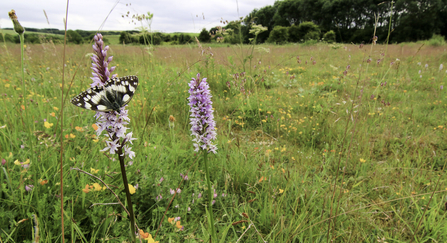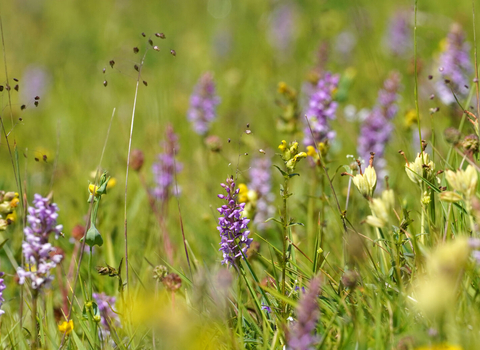What is Biodiversity Net Gain (BNG)?
By law, most new developments in England must leave nature in a better state than before, by improving or creating new habitats. This process is called Biodiversity Net Gain or BNG.
Biodiversity Net Gain is a mandatory approach to planning development in England. Developers are required to avoid damaging important wildlife habitats, offset any unavoidable losses, and go further by delivering at least a 10% net gain in biodiversity. This gain must be measurable and achieved by improving or creating habitats—such as hedgerows, grasslands, or watercourses—that are managed and maintained for at least 30 years.
When done well, BNG helps protect wildlife and contributes to the wider recovery of nature.
Biodiversity Net Gain explained
How will BNG affect businesses?
The new Biodiversity Net Gain regulations came into effect in early 2024. Developers in England must deliver a minimum 10% increase in biodiversity for new developments, for at least 30 years. For Town and County Planning Developments this came into effect in February 2024, followed by small sites from April 2024 and will come into effect for Nationally Significant Infrastructure Projects (NSIPs) from late 2025. This requirement can be achieved through the development of nature on the site itself, through the development of nature at other sites, or, as a last resort, through the purchase of statutory Biodiversity Net Gain credits.
Does Biodiversity Net Gain have to be delivered on the site of a new development?
There are three ways in which Biodiversity Net Gain can be delivered:
- Firstly, through on-site enhancement and restoration of biodiversity (within the red line boundary of a development site).
- Secondly, if all of the Biodiversity Net Gain cannot be delivered on site , off-site biodiversity gains can be considered. This can either be on land owned by the developer, outside of the development site or through buying off-site biodiversity units.
- Finally, if developers cannot achieve on-site or off-site Biodiversity Net Gain, they must buy statutory biodiversity credits from UK Government. This should be considered a last resort.
All three methods can be used, however they must be considered in order.
All habitats created for Biodiversity Net Gain must be managed and monitored for 30 years to achieve and demonstrate the planned uplift. When delivering Biodiversity Net Gain on-site developers must carefully consider how the Biodiversity Net Gain gains can be managed, monitored and protected (e.g. ensuring these areas will not be needed for future development) over the 30 years. When considering on-site gains it is also very important to consider how additional on-site pressures, for example from increased footfall, dog walkers and other human usage, can be balanced and accounted for within the planned uplift.
What are the legal requirements for offsite Biodiversity Net Gain?
The delivery of off-site Biodiversity Net-Gain must be secured with a comprehensive Habitat Management and Monitoring Plan (HMMP) and legal agreement. The legal agreement can either be in the form of a Section 106 (S106) with the Local Planning Authority or through a Conservation Covenant with a Responsible Body. Once the HMMP and legal agreement are in place, the off-site Biodiversity Net Gain must then be registered on Natural England’s BNG register, that opened in February 2024. Once the site is registered Biodiversity Net Gain units can be sold and included within planning permissions.
What work has The Wildlife Trusts done on Biodiversity Net Gain?
The Wildlife Trusts have been influencing the evolution of Biodiversity Net Gain for well over a decade – from the very early thinking and piloting in 2012 around measuring and offsetting the losses of nature to development, to testing and contributing to the multiple iterations of the Defra metric and advocating for clear commitments on Biodiversity Net Gain in legislation. Locally, Wildlife Trusts have been influencing the inclusion of Biodiversity Net Gain policy in local plans and advocating for voluntary Biodiversity Net Gain for many years.
Read more about the BNG work The Wildlife Trusts have been doing on their website.

Marbled white butterfly on a common spotted orchid in a wildflower meadow © Tom Marshall
Recent government consultation and proposed changes
Biodiversity Net Gain (BNG) benefits are being put at risk by new proposals from UK Government. They intend to remove the nature gain requirement for developments on small sites. As most development takes place on small sites, this means the vast majority would be exempt from BNG requirements in the future.
If these plans to weaken Biodiversity Net Gain go ahead, both nature and people will suffer. Building developments can have a huge impact on wildlife and if the requirement for Biodiversity Net Gain is lost nature will be squeezed into smaller and smaller pockets.
Wildflower meadows, wetlands and woodlands that would have been created will not exist. There will be less birdsong, fewer trees, less space for pollinators like bees... the list goes on.
Meanwhile, people will also lose out on the benefits that these spaces would have created. This isn't a question of nature or development. We can have both. But it has to be done right.
A public consultation was launched to gather people’s views on the proposed changes, and it closed on 24 July 2025.
Thanks to your support, 13,500 members of the public responded to Defra, all opposing the plans to scrap requirements for small developments. Many shared powerful personal stories and real-life experiences in their submissions.
The UK Government is expected to respond in the coming months, and we’ll keep you updated as soon as we know more.
How will these proposed changes impact Biodiversity Net Gain?
What do the current plans to weaken Biodiversity Net Gain really mean?
Biodiversity Net Gain provides a way to measure nature improvements within the planning system. It means that developers can fund habitat creation and that landowners, including farmers, can be rewarded for restoring nature.
Building developments can have a huge impact on wildlife and it’s only right that nature is not a victim. We support the principle that developers should make up for unavoidable loss by increasing natural habitats on-site or nearby.
Done well, Biodiversity Net Gain can help development to protect these valued spaces in the first place, or to create and enhance places, for wildlife and for communities nearby.
The proposal to change this fails to recognise the magnitude of the nature crisis – it will increase nature losses and cut wider public benefits in order to maximise profit for a few. Additionally, the changes are unlikely to speed up development as it doesn’t address the root causes of delays.
Are the plans all bad?
It isn’t all bad news.
In the current system, some nature recovery projects - like the creation of ponds and wetlands - have to go through the same planning process. That means the also need to deliver Biodiversity Net Gain. This extra legal requirement can sometimes mean these projects become unviable, so no benefits to wildlife are delivered.
We welcome this exemption, however, we cannot ignore the clear problems with other proposals.
Why do The Wildlife Trusts object to the small sites exemption?
Firstly, size doesn't always show how important an area is for wildlife. Even small building projects can cause big problems for nearby natural areas or break up the connections between different wildlife habitats.
Small losses add up over time. When many small areas are damaged or destroyed, together they create an even bigger problem than each one alone. In short – small developments can have big environmental impacts, and exempting more projects from BNG requirements could cause serious harm to both wildlife and people.
Planning and Infrastructure Bill
The Labour Party promised voters that they would protect and restore nature. But the new Planning and Infrastructure Bill is set to weaken environmental protections for developments, like housebuilding.
Despite tireless campaigning and thousands of people speaking up and contacting their MP, the UK Government will pass the Bill, causing detrimental damage to nature.
The fight isn't over. We will continue to stand up for nature, with your help.
Become a member and support our work
The vital work we do for nature depends on the support of people who care about the future of Devon’s wildlife and wild places.

